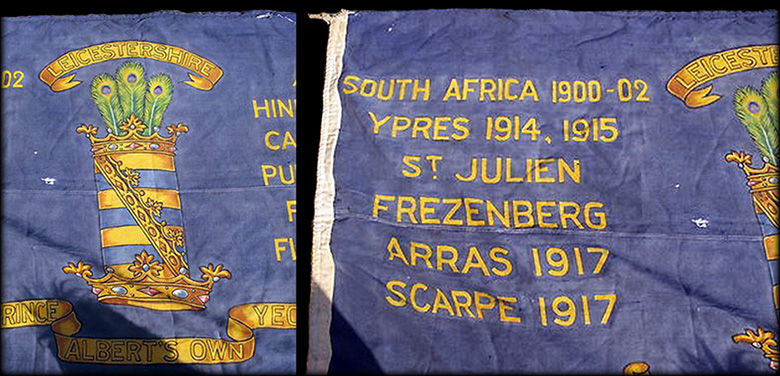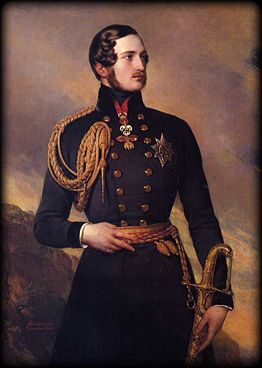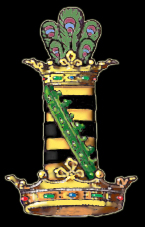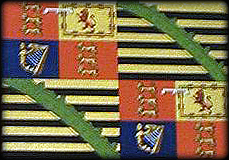|

World War 2

"1942, '44-45" |
| "NORTH
WEST EUROPE" |
"NORTH
AFRICA" |
| "ITALY" |
Battle Honours 1939-45
Certain units of Yeomanry and Infantry were used in other arms
during the war and were awarded an honorary distinction in the
form of a badge in place of Honours to denote their War service
as another arm. Such badges are carried solely on the Regimental
Standard, Guidon or Colours of the unit concerned.
Such
Yeomanry Regiments were not
converted to artillery, but fought in an artillery role wearing
their own badges and expressly and by official action remained
Yeomanry.
Badges and theatres with dates were eventually allowed.
153rd (LY) FR RA claimed: CAEN, BOURGHEBUS RIDGE, FALAISE, THE
NEDDERRIJN, THE SCHELDT, THE RHEINLAND, PURSUIT TO THE BALTIC
AND NORTH SEA.
154th (LY) FR RA claimed: EL ALAMEIN, ADVANCE TO FLORENCE,
CARIANO, LAMONE CROSSING, BOLOGNA.
1920-39 See Regimental & Squadron
Standards

Leicestershire PAO Yeomanry Regimental Banner
Post 1920 (pre WW2), flown on Camp, over HQ and other
Regimental functions.

World War 1
 |
| "YPRES,
1914-15" |
"AMIENS" |
| "ST.
JULIEN" |
"HINDENBURG
LINE" |
| "FREZENBERG" |
"CANAL
DU NORD" |
| "ARRAS,
1917" |
"PURSUIT
TO MONS |
| "SCARPE,
1917" |
"FRANCE
& FLANDERS, 1914-18" |
PAO Leicestershire Yeomanry Battle Honours 1914-18
(Research by John Sills LDY PAO)
BATTLE OF YPRES 1914. 21 Oct - 11 Nov. For operations in
Flanders 10/10 - 22/11
|
Locations; |
The Comines Canal to
Ypres, thence the Yser canal to Steenstraat : from there
the road to Bixscoote and, thence along the southern
edge of Houthulst Forest. |
| Battle; |
i. The Battle of
Langemarck 21-24 Oct
ii. The Battle of Gheluvelt 29 - 30 Oct
iii. The Battle of Nonne Bosschen 11 Nov |
In claiming the honour Ypres 1914, the Leicestershire Yeomanry
inquired whether having taken part in the Langemarck it was
eligible for the honour Ypres 1914, or must it have taken part
in all three battles. It appears then that the Leicestershire
Yeomanry had taken part in the Battle of Langemarck and was
eligible for the honour of Ypres 1914. (They landed in France
2/11/1914).
BATTLE YPRES 1915 22 Apr. - 25 May For Summer
Operations 1915 ( Mar - Oct )
| Locations; |
The Comines - Ypres
Canal as far as Voormezeele; thence road to Vlamertinghe
Chateau - Boesinghe - Langemarck. |
| Battles; |
i. The Battle of
Gravenstafel Ridge 22-23 Apr (including The Gar Attack)
ii. The Battle of St. Julien 24 Apr - 4th May
iii. The Battle of Frezenberg Ridge 8 May - 13 May
iv. The Battle of Bellewarde Ridge 24 May - 25 May |
The 7th Cavalry Brigade moved into the reserve position behind
Ypres on the 23rd of April. Both the honours St. Julien and
Frezenberg have also been awarded to the LY.
The Battle of St. Julien 24 Apr - 4 May
(see the Battle of Ypres 1915)
The Battle of Frezenberg Ridge 8 May - 13 May
(see the Battle of Ypres 1915)
The Battle of Arras, 1917 9 Apr - 4 May for the
Arras Offensive 9 Apr - 15 May
Tactical incidents occurring during the first battle of the
Scarpe include the capture of Monchy - le - Preux and the
capture of Wancourt Ridge. The Leicestershire yeomanry as part
of the 7th cavalry Brigade of the 3rd cavalry Division took part
in the capture of Monchy - le - Preux.
The Battle of Scarpe 1917 9 Apr - 14 Apr
(First battle of Scarpe) See the Battle of Arras, 1917.
The Battle of Amiens 8 - 11 Aug.
For the Advance in Picardy 8 Aug - 3 Sept 18.
| Locations; |
Between the roads
Amiens - Roye and Amiens - Albert (Amiens exclusive) |
The Battle of the Hindenburg Line 12 Sept - 9 Oct
for operations The Breaking of the Hindenburg Line
26 Aug - 12 Oct 1918.
|
Locations; |
(for canal du Nord)
Road Banteaux - Gouzeaucourt (exclusive) - Fins
(exclusive) - Ytres - Lagnicourt - Vis en Artois; thence
the river Sensee.
(for Cambrai) Road Fresnoy - Sequehart - Bellenglise -
Bellincourt - Vendhuille - Villers - Guislain - Villers
- Plouich - Graincourt - Bourlon - Oisy le Verger:
thence the river Sensee. |
| Battle; |
i. The Battle of
Havrincourt 12 Sept
ii. The battle of Epehy 18 Sept
iii. The Battle of canal du nord, including the capture
of Bourlon Wood, 27 Sept - 1 Oct
iv. The battle of the St. Quentin Canal 29 Sept - 2 Oct
v. The Battle of the Beaurevoir Line 3 Oct - 5 Oct
vi. The Battle of Cambrai 8 Oct - 9 Oct |
The Leicestershire Yeomanry holds the honour of the Hindenburg
Line and Canal du Nord for those operations and though it is not
certain at present whether they took part in the actual Battle
of Cambrai it was from the Cambrai Sector that they started the
final advance. (the final Advance was then changed to the
pursuit to Mons).
The battle of Canal du Nord 27 Sept - 1 oct
see Hindenburg Line.
The Pursuit to Mons (formerly The Final Advance)
28 sept - 11 nov 1918. For operations picardy 17 Oct
11 nov.
Locations;
|
Location; |
(Selle)
The Railway Boue - Busigny - Caudry; thence the stream
to its junction with the river Escaut: thence the
latter.
(valenciennes) The bavai - Cambrai road a sfar as
Vendegies: thence the streaam to its junction eith the
river Escaut: thence a line to Wallers: thence along the
southern edge of the forests of Vicoigne and
Raismes.
(Sambre - Passage of; Oise Canal and capture of Le
Quesnoy) The railway Boue - le Cateau (exclusive) thence
the road to Romeries - famars - Onnaing: thence the
railway to Mons.
(Passage of the Grande Honelle) Between the Bavai -
cambrai road and the Valenciennes - Mons railway, east
of the line Wargnies - Onnaing. |
|
Battle; |
i. The battle of the
Selle 17 Oct - 25 Oct
ii. The battle of Valenciennes including the capture of
Mont Houy 1 Nov - 2 Nov
iii. The battle of the Sambre including the Passage of
the Sambre - Oise Canal and capture of Le Quesnoy 4 Nov.
With the subsequent a) Passage of the Grande Honnelle 5
Nov - 7 Nov and b) The capture of Mons 11 nov.
|
Battle Honours for the Selle ; Valenciennes and the sambre were
all claimed by the Leicestershire yeomanry and were granted
within the honour "Pursuit to Mons".
France and Flanders 1914 - 1918. For
operations in that area between those dates.
The following operations were applied for but disallowed: - The
Battle of Bailleul including the defence of Neuve Eglise; the
1st Battle of Kemmel and the second Battle of Kemmel. These
battles took place between the dates 13 Apr and 26 Apr 1918 and
were part of the German Offensives of 1918. They are grouped
within the "Battle of Lys". The area includes the road Meteren -
Mont des Cats - Boeschepe - Reninghelst - Vlamertinghe - Ypres
(exclusive); thence the Comines Canal. The 3rd Cavalry Division
did a forced march to the Mons des Cats - Foret de Nieppe area
in reserve against the German attack which overwhelmed the two
Portuguese Divisions on the River Lys.
House of Commons Question Time : Leicestershire Yeomanry Battle
Honours
HC Deb 17 March 1925 vol 181 cc2048-9
2048
asked the Secretary of State for War
whether he will sanction the award of battle honours to
the Leicestershire Yeomanry for the period from March,
1918. until the Armistice, when the squadrons of that
regiment were attached to the three cavalry regiments
then comprising the 3rd Cavalry Brigade?
I greatly regret that I cannot depart
from the decision, which was arrived at by the Army
Council after careful and sympathetic consideration,
that the Leicestershire Yeomanry are not eligible for
the award of battle honours in respect of the period in
question. During this period
2049 the Leicestershire Yeomanry and other Yeomanry
regiments wore absorbed as reinforcements in the Cavalry
Corps, and did not take part in any engagements as
individual units. Their application could not be granted
without reopening one of the main principles on which
battle honours have been awarded.
Is the right hon. Gentleman aware
that the regiment of Life Guards went out as a composite
regiment and received battle honours at the beginning of
the War?
I am aware of that, but that does not
state the whole case, and I am afraid I cannot argue at
Question Time.
Is it not a fact that the
Leicestershire Yeomanry were brigaded as a unit in the
same cavalry brigade for nearly three years?
For all the time the Leicestershire
Yeomanry were fighting as a separate unit they have
received battle honours. The period in question was that
period during which their individual members were
absorbed in another cavalry regiment.
2nd Boer War
  |
| "SOUTH
AFRICA, 1900-02" |

Prince Albert, Prince Consort and Prince of Saxe-Coburg
Honoured the Regiment with the title:-

From the London Gazette
17th February
1844 - Present Day
Queen Victoria and the Prince Consort, whilst resident at
Belvoir Castle, were escorted by the Regiment on their travels
within the County. The Royal couple were so impressed by their
service the title "Prince Albert's Own" was bestowed on the
Regiment, becoming "Prince Albert's Own Yeomanry Cavalry".
Designate :- "to indicate and
set apart for a specific purpose".
Title :- "is a prefix or suffix
added".
The title and designation of "The Prince Albert's Own" has
always been retained, even after
amalgamation with the Derbyshire Yeomanry in 1957. The NCO arm
badge of the modern RY "B" Squadron still retains the title.
Prince Albert's "Armorial Crest", the Ducal crest of
Saxony, is worn by the
Leicestershire Yeomanry as a cap badge as direct result of
the title "PAO" and may not be worn otherwise. This means that the title can never be
dropped when referring to the LY (PAO), LDY (PAO) or any of
their descendant establishments as long as "The crest" is worn
in uniform or displayed in any other form in a regimental
context.
B (LDY PAO) Squadron, RY, is the only unit in the British Army
that still wears Prince Albert's crest and the title PAO as part
of their uniform and insignia.
The tradition of being the "Prince Consort's" regiment has been
maintained by HRH The Duke of Edinburgh by being Honorary
Colonel to the LY (PAO) and his kind Patronage to its
descendants.
The crest of the Prince Consort:
A conical cap charged with the arms
of Saxony (Barry of ten, Sable [Black] and
Or [Gold], a Rue Crown in Bend, Vert
[Green]). Crowned Or [Gold] and surmounted by a
Peacock's tail proper [5 feathers].
 |
 |
| Arms of the Kingdom of Saxony |
Ducal Crest of Saxony |
 |
| The Royal Standard of Prince Albert, the
Prince Consort. |
** The 11th (PAO) Hussars also had the same honour of the
"title" and also wore the Prince Consort's crest in this
respect. The 11th Hussars are now amalgamated into the Queens
Own Hussars and the only visible reference to their heritage is
retained on the regimental Guidon. Both the 11th and the LY have
been referred to as "Prince Albert's Own Hussars".
** The only "other" Yeomanry Regiment to have the same title of
"Prince Albert's Own" (later than the LY) was the Norfolk
Yeomanry, however, they disbanded in 1868. It was King
Edward VII express wish that the Norfolk Yeomanry be
raised again as "The Kings Own Royal Regiment (Norfolk
Yeomanry)" in 1901, possibly because they were once Prince
Albert's Own.
|

